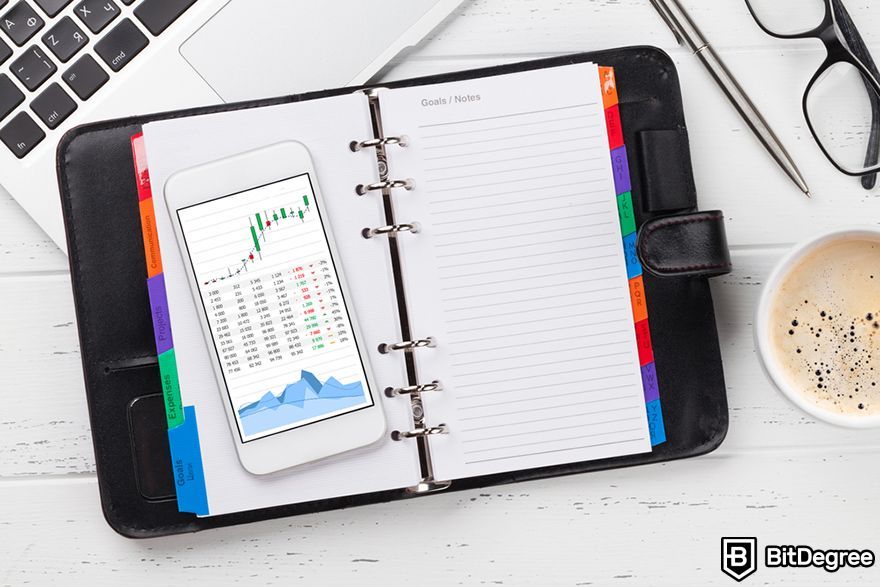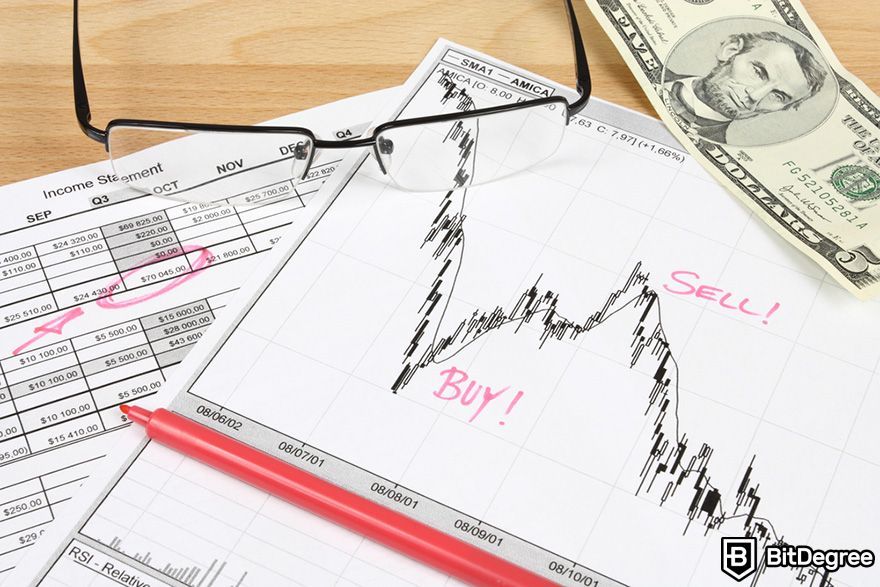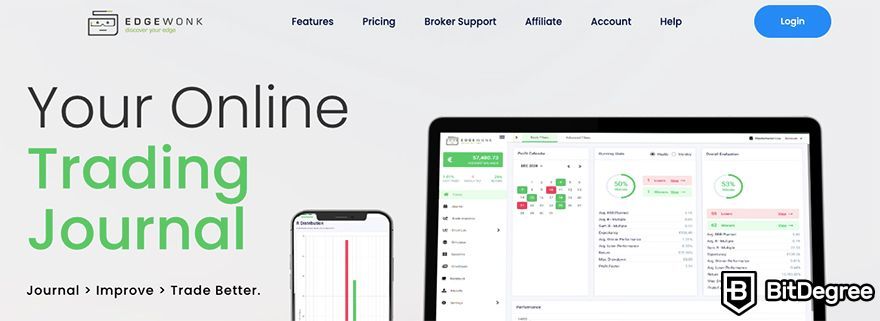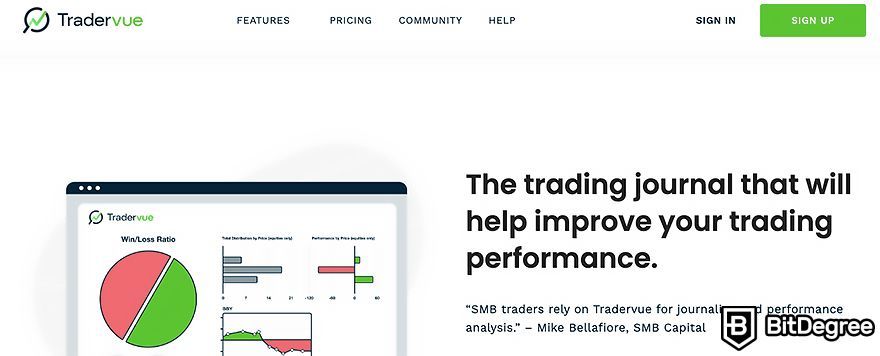Key Takeaways
- A trading journal is a record of your trading activity that can help you track your performance over time, identify patterns in your trading behavior, and stay organized;
- There are many ways to create a trading journal – you can use an Excel spreadsheet, a notebook, or a dedicated trading journal software;
- Some common parameters tracked in trading journals include the cryptocurrency in question, entry and exit prices, profit or loss, the reasons for entering and exiting the trade, and the trading strategy.
Free Airdrop Season 7 is LIVE! Answer fun questions or do simple tasks to earn rewards from the $30K BitDegree prize pool. Participate Now ! 🔥
When it comes to trading, relying on instinct alone may not be enough. This is where trading journals come in handy. But what is a trading journal for crypto, and how to use one?
Put shortly, imagine your crypto trading journal as a personalized diary, capturing all of the important information of each trade. However, it's not all about the numbers; it also unravels trading patterns, successes, and setbacks. Many crypto trading journal apps are integrated with popular exchange platforms, such as Binance, Kraken, or KuCoin, to make it easier to keep track of your activity.
However, let’s delve into the concept of what is a trading journal in more detail, exploring how it can refine trading tactics, and illustrating its role in bridging raw trading data with a strategic approach.

Did you know?
Subscribe - We publish new crypto explainer videos every week!
Is Your Crypto Safe? (5 Best Crypto Security Practices Explained)


Table of Contents
- 1. What is a Trading Journal?
- 1.1. How Does a Trading Journal Work?
- 2. Pros and Cons of Using a Trading Journal
- 3. How to Create a Crypto Trading Journal?
- 3.1. Trading Journal Format
- 3.2. Tracking Parameters
- 4. Best Crypto Trading Journals
- 5. How to Use a Crypto Trading Journal?
- 5.1. Should You Use a Trading Journal?
- 6. Conclusions
What is a Trading Journal?
So, what is a trading journal for crypto, exactly? Well, it quite literally is like a diary that keeps a record of your trading actions. It contains all the information about your transactions, including cryptocurrencies you've bought or sold, trade dates, reasons behind your decisions, profits and losses, and your reflection on outcomes.
Latest Deal Active Right Now:Head to BitDegree Missions, gather as many Bits as possible & claim your stake of the $30,000 Prize Pool! Don't waste your time & start collecting Bits by completing Missions and referring friends.
Do note that you have to fill in that information manually, unless you use a crypto trading journal software that offers automatic journaling (you'll still have to fill in your strategies and purchasing reasons yourself, though).
As traders delve into what a trading journal is, it becomes clear that it’s more than just random scribbling. It actually is a valuable tool that helps you learn from your successes and failures, identify patterns, and refine strategies.
Now, other than asking, “What is a trading journal?”, you might also ask, “Why bother with manual notes when you have sophisticated trading tools and charts?”. Well, a crypto trading journal complements those tools by offering a personal touch. It's not about substituting technology; it's about adding a human element to your trading approach.
How exactly does it work, though?
How Does a Trading Journal Work?
Understanding how a trading journal works is as easy as understanding what is a trading journal. Firstly, note that you can make a crypto trading journal Excel spreadsheet, as well as use a notebook or a dedicated crypto trading journal app.
Now, when you make a trade, you have to jot down key details in your trading journal: the date, the cryptocurrency involved, price, quantity, profits and losses, etc. You can also record the reasons behind your trading choices, your strategies, relevant information regarding that particular trade, and the outcome.

Over time, this journal becomes a compendium of insights. Patterns emerge as you review your past trades. You might notice that certain tactics yield better results than others, or that emotions influence your decisions. These realizations empower you to refine your approach.
After all, what a trading journal is but a treasure trove of information, holding the keys to unlocking trading prowess and potential.
Pros and Cons of Using a Trading Journal
If you came here asking yourself, “What is a trading journal?”, it must be clear by now that it's a game-changing tool for your trades. However, like any other resource, a trading journal for crypto holds both advantages and disadvantages.
Pros
- Improved Trading Performance. By tracking your trades and analyzing your performance, you can identify areas for improvement and develop a more profitable trading strategy.
- Reduced Emotional Trading. Analyzing your trading choices can help you stay disciplined and avoid making emotional decisions.
- Increased Motivation. Tracking your progress helps you stay motivated and keep going.
- Decision Helper. When you're not sure whether to buy or sell, your journal can remind you of similar situations in the past to help you make a decision.
- Goal Tracker. Your journal keeps tabs on your progress, like a fitness app for your trading goals.
Cons
- Time-Consuming. It can be time-consuming to keep a trading journal, especially if you are a frequent trader.
- No Instant Results. Your journal won't magically boost your trading skills overnight. It's a long-term journey that will only help you see places for improvement over time.
- Privacy Concerns. Your journal might have sensitive information about your trades. That means you have to be careful about where you keep it or who you share it with.
Now, if the pros outweigh the cons for you, we can proceed to the more practical part and talk about crypto trading journal creation.
How to Create a Crypto Trading Journal?
Since you already know what is a trading journal, you’re probably curious about how to make one as well. As mentioned before, there is always the option of using trading journal apps. You’ll find some free crypto trading journal templates and trading journal app recommendations below. However, if you're looking for a more personalized option, here are some tips on how to make your own.
Trading Journal Format
The first thing you’ll want to do is choose a format for your journal. You can make a free crypto trading journal in Excel, Google Sheets, or a notebook. If you prefer, you can also combine the spreadsheet with a written document to record thoughts, instead of putting everything into a single crypto trading journal template spreadsheet file.
Note-taking apps, like the ones you have on your phone or computer, are also a good option. They are versatile, easy to use, and can be utilized to store other information that is relevant to your trading. Besides, you can access your notes from any device, so you can track your trades on the go.

Tracking Parameters
You will also have to decide what you will track in your journal. While there are many examples of trading journals available online, the specific columns included in your spreadsheet may vary depending on your individual needs. Make sure to track relevant information that will actually help you in the future.
Some essential columns that should be included in any trading journal for crypto are:
Cryptocurrency
This one is pretty obvious and unavoidable, as you have to mark which specific crypto asset you traded. It’s important to track this information so that you can see which cryptocurrencies you have been most successful with and which ones you might want to avoid.
Trade Type (Buy / Sell)
That means whether you bought or sold the cryptocurrency. This information is important to log into your journal so that you can see your win / loss ratio for each type of trade when you’re analyzing your data in the future.
Exchange Platform Used
Whether you use Binance, Kraken, KuCoin, or other exchange platforms, it is important to note this down so that you can see which exchange platforms proved to be more reliable or which ones had the best fees.

Date and Time
You might want to log the date and time on which you entered and exited a trade. This will help you determine time- and date-specific factors when making trading decisions to maximize your profits.
For example, you might be able to buy a cryptocurrency at a lower price during a midday trading lull, when the most relevant news stories have already been reported, and the price of the cryptocurrency is likely to be lower.
Trade Direction (Long / Short)
Keep track of whether you have long or short positions in cryptocurrencies to assess your trading strategy. Long positions are when traders bet on rising prices, while short positions are a way to bet on falling prices.
By understanding your positions, you can make better decisions about when to sell or buy and increase your profit margin.
Entry Price, Exit Price, and Stop-Loss
The prices at which you entered the trade, exited the trade, and set your stop loss are valuable data to keep track of.
Investors can set a stop-loss order to sell an asset automatically if the price falls below a certain level. This mechanism, in theory, helps to minimize the loss of your funds if the price of an asset falls sharply. However, some studies suggest that it might not be that efficient in preventing fund loss[1].
Nevertheless, this information will help you see how much profit or loss you made on each trade.

Profit and Loss (Outcome)
You surely want to mark whether a trade was a success or a failure (and how much you've gained or lost, of course). It’s important to track it to see how profitable your trading strategy is and which trades you need to improve on.
Reasons for Entering / Exiting the Trade
As mentioned before, it is very important to input personal notes in your trading journal. You’ll want to reflect on your decision-making parameters to identify trading mistakes and wins to adjust your future strategies accordingly.
Other relevant information
If you want, you can also point out other relevant information that might be related to your trade. This could include things like any specific news that triggered the trade or the technical analysis that you used to make it.
Overall, always be as detailed as possible when recording your trades. This will help you analyze your performance later on and identify patterns in your trading.
Speaking of which, remember to analyze your trades regularly so you can stay on top of your trading by identifying areas for improvement. This will also help you avoid having to deal with an overload of data at once, which can be overwhelming and lead to you giving up on keeping your trading journal.

Understanding what a trading journal is can greatly enhance your ability to refine your crypto trading strategies over time. Just don't forget to be honest with yourself when recording your trades, so you can get the most out of your trading journal and improve your trading skills.
However, if you’re not into making your crypto trading journal from scratch, there are a number of templates available online that can provide you with a proper foundation.
For example, Binance offers a free crypto trading journal Excel template. It's an Excel spreadsheet that tracks all of the essential details of your trades, such as the date, time, cryptocurrency, entry price, exit price, and profit or loss. You just have to make a copy and start filling in your information.
Though, if you want to enhance your experience even more, you can also use crypto trading journal software.
Best Crypto Trading Journals
Okay, so you know what is a trading journal and how to create one, but you don’t really have the time or inclination to make your own. Fortunately, there are a number of crypto trading journal apps, each with its own strengths and weaknesses.
Here are some of the best crypto trading journal apps available, according to many crypto enthusiasts:
TraderSync

TraderSync is a comprehensive and powerful trading journal that offers a wide range of features, including trade tracking, analysis, and reporting. It does get a bit pricey with better plans, but still is a pretty suitable choice for experienced traders who want to improve their trading performance.
It allows trade tracking, including entry and exit prices, stop losses, and profit targets. The platform generates reports on your performance over time and easily integrates with other trading platforms and exchanges.
Coin Market Manager

Coin Market Manager offers a basic but effective set of features for tracking trades. It’s not as feature-rich as TraderSync, for example, but it is a good option for beginners and those who are looking for a simple and easy-to-use trading journal.
You can track your trades, including entry and exit prices, stop losses, and profit targets. It’s possible to track portfolio performance as well and to see how your trades are affecting it. Furthermore, all data is stored in the cloud, so you can access it from anywhere.
Edgewonk

Edgewonk is a cloud-based trading journal that offers a number of features for analyzing trades. It’s a suitable option for traders who want to track their performance and identify areas for improvement.
It also allows you to backtest your trading strategies to see how they would have performed in the past, as well as identify and manage your risk exposure. Thus, you can practice trading without risking real money. Additionally, you can join a community of traders to learn from others and share your own insights.
Journalytix

Journalytix is a trading journal that uses artificial intelligence to help traders improve their performance. It offers a number of features for tracking trades, analyzing performance, and identifying areas for improvement.
The platform offers AI-generated feedback to enhance your trading performance, enabling you to refine your strategies. Moreover, it allows monitoring and analysis of your performance over time.
TraderVue

TraderVue is a cloud-based trading journal that offers a large set of features for tracking trades, analyzing performance, and identifying areas for improvement.
You can track your trades, generate reports to analyze your performance over time, integrate with other trading platforms and exchanges, and customize your journal to fit specific trading strategies.
To sum up it all, here is a comparison of these platforms:
| Platform | Price | Pros | Cons |
|
CoinMarket Manager |
Free Basic plan; $69.99/month for Pro plan; $89.99/month for Enterprise plan. |
Easy to use; Provides detailed analytics; Has a free plan. |
Limited features; Limited crypto exchange support. |
| TraderSync |
$29.95/month for Pro plan; $49.95/month for Premium plan; $79.95/month for Elite plan. |
Automatic trade metadata wealth tracking; Suitable for experienced traders; Detailed reports. |
The Basic plan only allows tracking one account; Not all charting axes are adjustable. |
| Edgewonk | $169.00/year *Prices might vary depending on the country |
Powerful backtesting features; Affordable; Suitable for experienced traders. |
Better for short-term investors; Has a steeper learning curve. |
| Journalytix | $47/month or $399/year |
Backtesting; Real-time news updates; Automated journaling. |
Might be a bit too complex for beginners; |
| TraderVue |
Free Basic Plan; $29.00/month for Silver plan; $49.00/month for Gold plan. |
Built-in reports and analytics; Has a free plan; Competitive pricing. |
Doesn't offer a mobile app. |
Table: Comparison of crypto trading journal prices, pros, and cons
Choosing the best crypto trading journal for your needs can significantly improve your trading. But how to know what is a trading journal app you should choose? Well, if you are an experienced trader who wants a wide range of features, TraderSync is a decent option. If you’re just getting started and are looking for something more affordable, on the other hand, TraderVue might be a better choice.
Besides, if you don’t feel like investing in a trading journal, you can always use a free template and customize it or create one from scratch (since you already know how). No matter which way you choose, it's important to track your trades regularly and to get the most accurate insights.
How to Use a Crypto Trading Journal?
You’ve learned what is a trading journal, how to create one, and what are the best crypto trading journal platforms available. Now what? Well, it’s time to learn how to use it effectively.
Step 1: Be consistent and precise. This means logging in the details of every trade you make, regardless of whether it was a win or a loss. Treat your journal like a diary – take a few minutes after every trade to record the trading information.
Also, make sure to document everything. Note the date, time, cryptocurrency, trade type (buy / sell), price, quantity, profit / loss, and the reasons behind your decision. Describe how you felt, what your insights are, or which relevant events happened on that day that might have influenced your decisions.
Here’s an example of what a trading log may look like:
|
Winning Trade Date: July 15, 20XX Time: 10:30 AM Cryptocurrency: Bitcoin (BTC) Exchange Platform Used: Binance Trade Type: Buy Price: $32,000 Quantity: 0.05 BTC Reason: Technical analysis indicated a bullish trend, RSI below 30. Outcome: Sold at $35,000. Notes: Successful trade based on oversold conditions. Need to explore similar setups. |
Step 2: Analyze your trades. This means looking at your trade history and identifying patterns. For example, you might notice that you tend to make more profits when you trade certain cryptocurrencies, or that you tend to lose money when you trade on certain days of the week.
You can analyze your trades by looking at your win rate, average profit or loss, and your profit factor. Keep in mind that it is also important to review how your emotions influenced your decisions. This insight can help you manage emotions in future trades.
Step 3: Adjust your approach to improve your trading. This means using the information you've gathered to make changes to your trading strategy. Maybe you've realized that you tend to make more profits when you trade certain cryptocurrencies, so you can focus on trading those cryptocurrencies more often.

It's no secret that emotional trading can impact the overall fluctuation pattern in investor returns[2], potentially leading to significant price shifts that can influence the financial market. So, if you've noticed that you tend to make emotional trades when the market is volatile, you can develop strategies to manage your emotions.
Overall, make sure to set goals for your trading, plan your targets, and track your progress toward achieving them. On top of that, make it a routine to review your journal at specific intervals. This ongoing analysis ensures you stay on track and continue learning from your past actions.
Your trading journal is more than a record-keeping tool, it's your guide to becoming a smarter, more strategic trader. By comprehending what a trading journal is and thoroughly maintaining one, you'll gain insights that can make a real difference in your trading success.

- Secure and reliable
- Accepts fiat currencies
- Lots of trading options
- Reputable exchange
- Accepts fiat currencies
- Offers various trading options

- Fiat currencies - accepted
- Simple to use
- Accepts only the most trustworthy cryptocurrencies
- A leading cryptocurrency exchange platform
- Best for beginner investors
- Accepts fiat currencies

- Fully reserved and transparent
- Multiple tradable asset classes
- Over 300 supported cryptos
- Over 300 cryptocurrencies
- Secure & transparent
- Fully reserved
Should You Use a Trading Journal?
Now that you know what a trading journal is, how to create one, and how to use one, you might be asking yourself, "Do I really need a trading journal for crypto?". Well, the answer depends on a few key factors, such as your trading style, goals, and mindset.
If you're someone who makes occasional trades, a trading journal may not be an essential tool for you. However, if you're deeply engaged in the market and make frequent, calculated moves, a trading journal can provide valuable insights.
Moreover, if you often find yourself making trading decisions that lead to undesirable outcomes, a trading journal can help you. By meticulously recording and analyzing your trades, you can uncover patterns in your mistakes and make informed adjustments to your strategies.

Maintaining a trading journal does require an investment of your time, but it can definitely pay off the effort. Just as you dedicate time to researching different cryptocurrencies and analyzing market trends, allocating a portion of your time to journaling can yield substantial returns in terms of improved trading performance.
All things considered, whether or not you use a trading journal is a personal decision. However, if you're committed to refining your trading strategies, learning from past experiences, and cultivating a more systematic approach to trading, a trading journal can definitely serve as a powerful ally.
Conclusions
So, what is a trading journal? Put simply, it’s literally what the name suggests – a journal where you log information about your trades. You can either create your own trading journal from scratch, use a free crypto trading journal template, or a crypto trading journal app. The type of the best crypto trading journal for you will depend on your trading style.
Keep in mind that crypto trading journal apps offer a variety of features that can help you improve your trading. In addition, most of them can be integrated into the most popular crypto exchanges, like Binance, KuCoin, or Kraken.
However, crypto trading journal apps tend to get quite expensive, so maybe it’s best to make your own journal. After all, what is a trading journal, but a chronicle of your crypto trading journey? In that sense, capturing every trade, decision, and thought along the way yourself might be more beneficial.
The content published on this website is not aimed to give any kind of financial, investment, trading, or any other form of advice. BitDegree.org does not endorse or suggest you to buy, sell or hold any kind of cryptocurrency. Before making financial investment decisions, do consult your financial advisor.
Scientific References
1. A. Y. C. Lei, H. Li: 'The Value of Stop Loss Strategies';
2. A. Yongkil, K. Dongyeon: 'Emotional Trading in the Cryptocurrency Market'.













